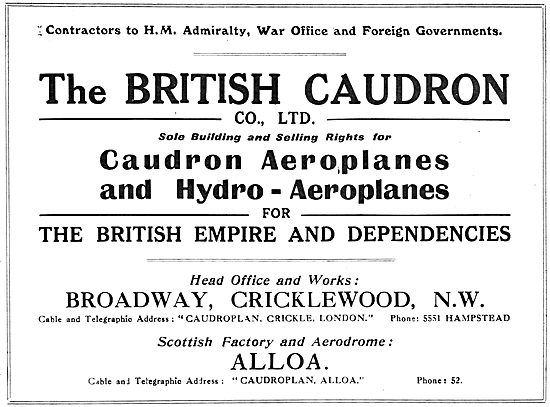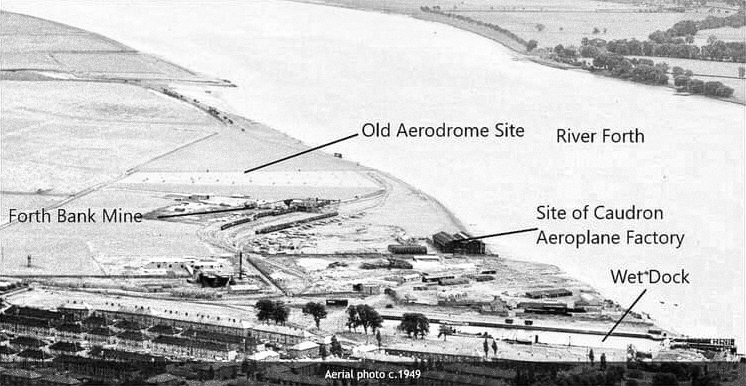Caudron Brothers
Gaston and Rene Caudron established an airplane factory at Romiotte, France in 1910. Caudron Freres (Caudron Brothers) soon began building wooden aeroplanes of their own design. The maiden flight of their first biplane was in February 1911. They produced several aeroplane types. Their Caudron G.lll model was considered extremely reliable and was used widely as a reconnaissance aircraft and as a trainer during the First World War.
G.IIIAs were built for military use from 1914 and were used extensively by France, U.K., Belgium, Russia and Italy as two-seat reconnaissance / artillery observation aircraft. Several hundred were built, mostly in France, but also in Italy and by British Caudron in the UK.
Series production continued with G.IV (1915), with several military variants; also, in that year the prototype R.4 three seat bomber was introduced.
The company had moved to Issy-les-Moulineaux, near Paris by 1919, and postwar products included the C 23 / C 232 two-seat biplane, which inaugurated French commercial air services on February 10, 1919, with flight from Paris to Brussels and the C 61 three-engined six/eight passenger biplane.
The company, now known as Societe Anonyme des Avions Caudron, ran into financial difficulties and was reorganised as Societe Caudron-Renault. They became notable for distinctive streamlined aircraft from its designer Marcel Riffard, who joined in 1932. His C363 took second place in 1933 Coupe Deutsch race; developed versions took first three places in 1934 and 1935, first two places in 1936. Two series of light fighters developed from Coupe Deutsch racers: following C 710 and C 713 prototypes, four-gun C 714 entered service. Improved variants CR 760 and 770 under development when France collapsed during the Second World War. Their factories built aircraft for Germany during the Occupation. Later nationalised as Ateliers Aeronautiques d'lssyles-Moulineaux; incorporated into SNCAN in late 1945.
William Hugh Ewen
William Hugh Ewen (1879-1947) was a pioneering Scottish Aviator. Born 1st December 1879 in Shanghai of Scottish Missionary parents, William Stevenson Ewen and Selina Blakeway, he travelled to Edinburgh in 1882 where his father became the Master Printer at Messrs. Peddle, Ewen and Co, Edinburgh. He was the fifth Scottish aviator to gain his pilot's certificate from the Royal Aeronautical Club, on 1st Feb 1911.
Forth Crossing
He took a flight across the Firth of Forth on the 31st of August 1911. The double journey across the Forth was made on his Deperdussin monoplane. Starting from the Marine Gardens of Portobello, he rose to 1,000 feet, and passing Inch Keith went on until within a mile of Kinghorn. He then turned and proceeded up the Firth in the direction of Leith. Two miles from the port he once more turned, and this time headed for his starting point at Portobello. He lined up for a landing but having decided that the Sports Ground was too restricted for landing, he flew outside the ground, and descended in a field in the neighbourhood. As soon as the mechanics arrived the wings were taken off and the machine wheeled back to the aerodrome. The flight took about ten minutes, and covered roughly twelve miles, and was the first flight over the Forth.
Previously W.H. Ewen had founded W.H. Ewen Aviation Co Ltd. In May 1911 he opened the Lanark Flying School, with flights in June that year, before moving in 1912 to Hendon near London. Once there he set up his second Flying School.
He was instrumental in teaching many to fly at the Ewen Flying School, Hendon before becoming a Lieutenant in the Royal Flying Corps on the 15th of November 1915. In November 1916 the War Office commandeered the flying schools at Hendon, after which the aerodrome trained 490 pilots. All passed on the Caudron biplane, which was later supported in the UK by the British Caudron Company.
He transferred to the Royal Air Force on the 1st of April 1918 in the rank of Major, before resigning his commission due to ill health.
He died in Edinburgh of cancer on the 26th of November 1947.
Caudrons built in Britain
At the end of 1911, W.H. Ewen had contacted the Caudron Brothers and in April 1912 his company, W.H. Ewen Aviation Co Ltd, Hendon, became the registered agent for the construction, maintenance and sale of Caudron aeroplanes in the British Empire. He started with a facility at Hendon.

However, by 1914 Mr.Ewen was no longer connected with the firm, and so it was decided to change the name of the W.H. Ewen Aviation Co. Ltd. to the British Caudron Co, Ltd. The business continuing under the management of Mr. Ramsay and Mr. Hunter. At this time, it was decided to move the manufacturing and repairs away from Hendon to a facility at Cricklewood, initially providing product support to French Caudron aircraft being operated in Britain. The new factory opened in January 1915.

British Caudron built Caudron G.IIIs under license. They built D.H.5s under subcontract to the Aircraft Manufacturing Co Ltd., B.E.2s under subcontract to the Royal Aircraft Factory and F.1 Camels under subcontract to Sopwith Aviation Company Ltd.

The Alloa factory was operated by the British Caudron Company from January 1916 until 1924, building mainly Sopwith Camels and Royal Aircraft Factory (RAF) B.E.2c machines. They had a contract for 100 Sopwith F.1 Camels (C6701 to C6800) which was split between the two factories and built between the spring of 1918 and early summer of 1919.

Sopwith Camel Biplane
The Alloa facility manager and test pilot was Rene Louis Desoutter (1892-1962) who hailed from London.

1924 Ordnance Survey map showing the Alloa Caudron Aeroplane Factory
The Alloa Aerodrome was built where the Forthbank Recycling Facility currently stands.

Picture from Facebook - Old Alloa Photos Group
The company didn’t make aeroplanes after 1919. The company moved into making furniture but went into liquidation in 1924.
You can find out a little more about the Sopwith Camel here: https://www.baesystems.com/en/heritage/sopwith-camel
Information sources for this article include :
Facebook - Old Alloa Photos Group
1stFlyingScot.co.uk - via The Wayback Machine
